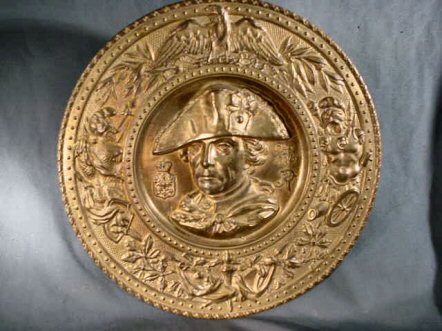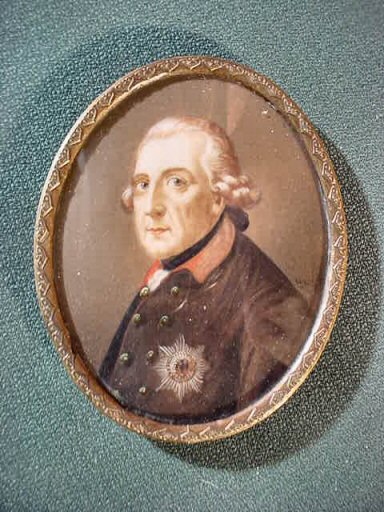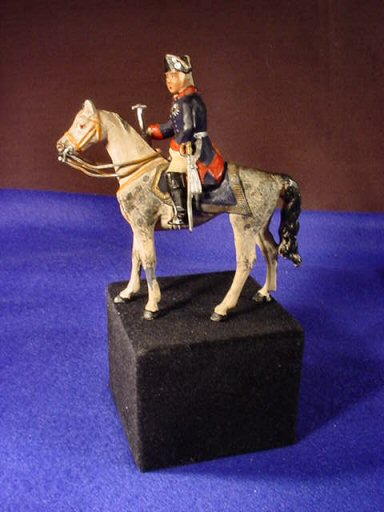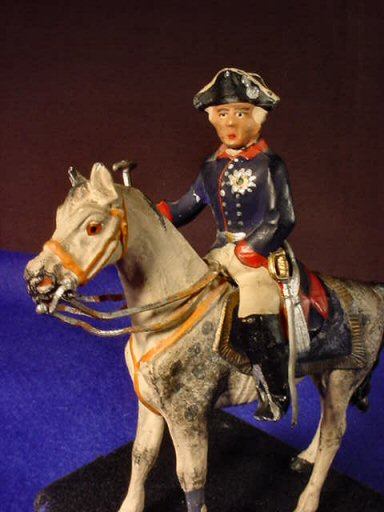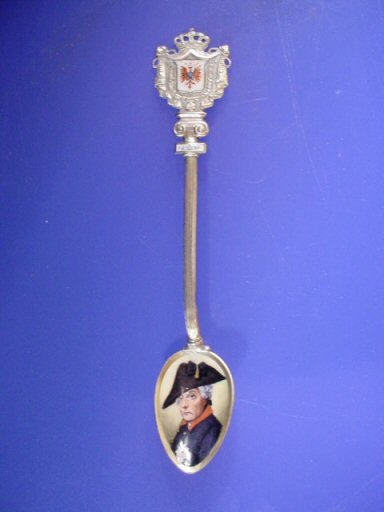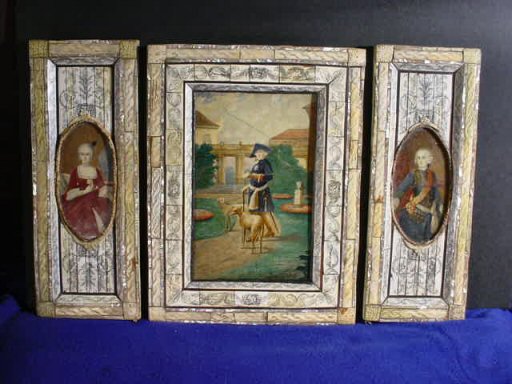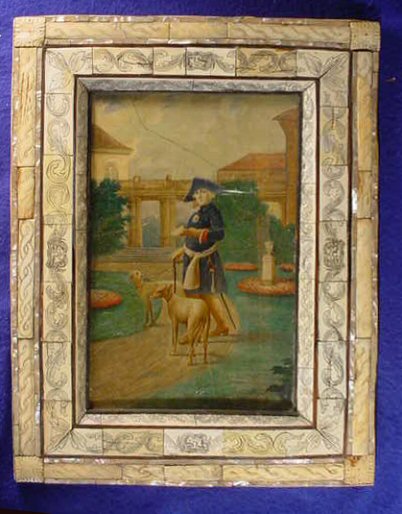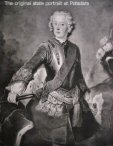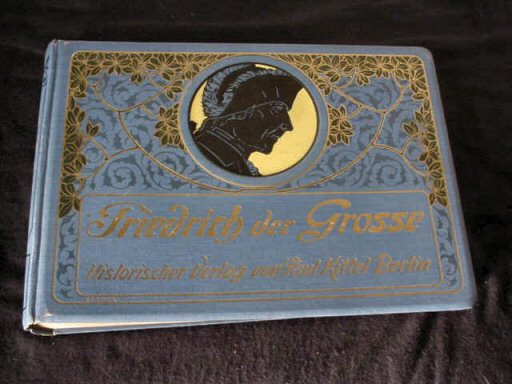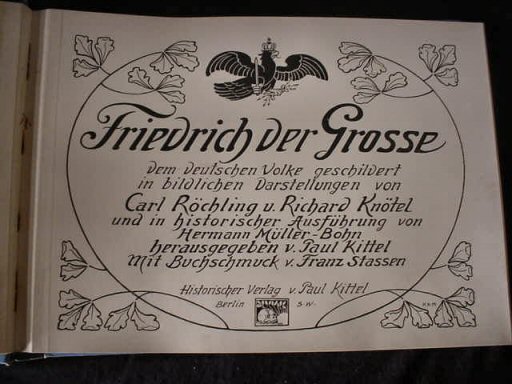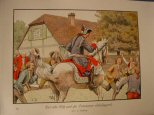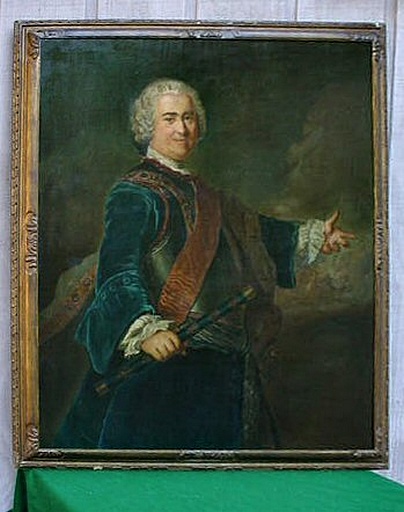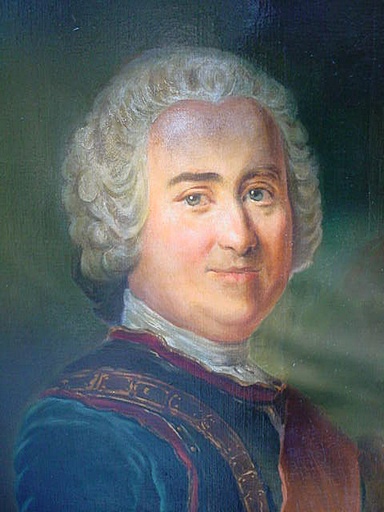|
|
|
|
Frederick the Great
Page 3
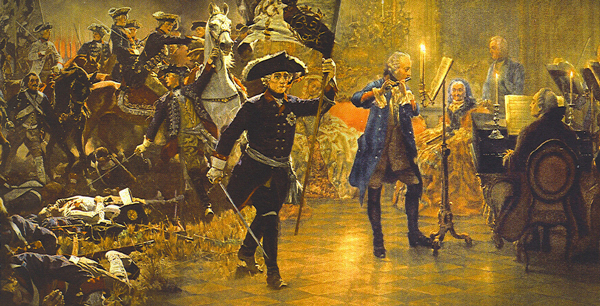
|
||||||||
|
Plaque Depicting Frederick the Great (Item FRED 3-2) |
||||||||
| DESCRIPTION: Here is a very dramatic plaque with the likeness of Frederick of Prussia, 1740-1786. The item looks to be brass with old gilting still showing. the head of the great king is a very good likeness as the young monarch at the peak of his military exploits. The eagle of Prussia appears above him and the house of Hohenzolern eagle with Prussian crown is seen on the left. The surrounding design is decorated with various militaria motif such as armor, cannon, lances, swords, banner, shield, and torch. It measures 18 inches in diameter. This is a very nice historically important piece of 19th-century patriotic décor.
PRICE: $225.00 |
|
|||||||||
|
Bronze Sculpture of Der alte Fritz (Item FRED 3-4) |
|||||||||
| DESCRIPTION: Frederick the Great, King of Old Prussia, and Warrior King (father of Prussian militarism) is revered in Germany like no other; even in Germany’s ultraliberal society of today. Even in the Orwellian nightmare of German government circles this noble and heroic figure has his admirers. This sculpture is taken from the famous portrait of Frederick resting after the Battle of Torgau. The bronze is 4 1/2 inches high and 3 1/2 inches wide at its widest point. The detail is great with the sword being a separate piece. The artist, O. Atarath, is signed to the back of Fredrick’s traveling war chest that is seated upon. So, here he is, the original Fritz; the embodiment of Prussian martial glory. The statue probably dates in the 1800s.
PRICE: SOLD |
|
||||
|
Early Period Hand-painted Portrait of Frederick (Item FRED 3-5) |
||||
| DESCRIPTION: Here is another hand-painted portrait of the great man, Unser Fritz. This miniature portrait measuring 3 x 2 1/2 inches is an exquisitely done rendering in its original frame. It probably dates from the early 19th century. We have carefully removed the back and can absolutely state unequivocally that the portrait is painted in that early period. The likeness of Der alte Fritz is absolutely wonderful with great color and lifelike detail. This is truly a museum-quality rendering.
PRICE: $680.00 |
|
||||||
|
Metal Figure of “Der Alte Fritz” (Item FRED 3-6; KTOY 1-5) |
||||||
| DESCRIPTION: This equestrian figure of the Prussian Kaiser, Frederick the Great, is quite dramatic in fine detail and is most definitely from the 1890s. It depicts the king mounted for battle on his white steed. His ever-present walking stick that served as his baton is clutched in his right hand. The reins of the horse are separately affixed. The famous blue, Prussian tunic is decorated with the Order of the Black Eagle, and his sword is by his side. All in all, this is one great 1890s figure. It stands about 4 3/4 inches high to the top of his three-cornered hat and measures about 3 3/4 inches from the horse’s snout to his tail. For such an early figure, it’s in remarkably good condition with all paint original. There are no repairs and it stands firmly upon the four hooves.
PRICE: $225.00; an 1890s treasure |
| ||||||||||||
|
Art Spoon Depicting the Bust Portrait of Frederick the Great (Item FRED 3-7; SPOONS 1-4) |
||||||||||||
| DESCRIPTION: Here is a magnificent portrayal of the greatest of the 18th-century heroes, “der Alte Fritz,” called that back then and even today by those who adore him. Wilhelm II and even Adolf Hitler thought him to be the greatest military strategist of all time. Frederick II called “the Great” 1712-1786 he was of the Hohenzollern dynasty and he ruled the kingdom of Prussia from 1740 to 1786. Frederick was known as an enlightened monarch. He was born in Berlin, the elder son of the soldier king Frederick Wilhelm I. His father created a formidable army and this set the pattern for the illustrious military career of his son Frederick and a brilliant following it most assuredly was! His victories were accomplished when defeat was decidedly certain. All of this immortal saga can be found on various websites so we will not digress further on it only to say that here was the real father of Prussian militarism and Germanic civil progress as well. There is a German saying that goes: “Alle die ganze Welt gegen Uns,” “All the whole world against us!” It certainly seemed that way back in Frederick’s time but through absolute greatness in military technique and troop deployment this immortal German hero prevailed. The spoon is one of a collection that we recently acquired in Germany and these pieces are the crème de la crème of the lot and this one is among the best of the best! The warrior king is shown at the height of his victorious years wearing his three-corner campaign hat and the Order of the Deutscher Schwarze Adler on his breast like the others in the collection the lifelike countenance is remarkable and considering that it is hand painted, you will agree its incredible. The work of a master miniaturist working at the turn of the 18th to 19th century the spoon is crafted in genuine ‘800’ silver and is so stamped along with a company logo the finial is decorated with the early Prussian crown of the empire with the red-eagle design in its center in enamel this is surrounded by the drapes of the Prussian coat of arms. The spoon is almost 5 1/2 inches long and is in top condition. Read more about these magnificent art spoons in our other descriptions.
PRICE: $495.00 |
|
||||||||||||||||||||||||||||
|
Fantastic Triptych in Ivory of Frederick the Great (Item FRED 3-8) |
||||||||||||||||||||||||||||
| DESCRIPTION: Here in all of its 18th-century glory is a wonderful triptych depicting scenes from the life of Frederick the Great of Prussia. For an all-to-brief summary of the life of one of the world’s greatest kings go to Item FRED 3-7. A triptych (pronounced "trip-tick) is a work of art which is divided into three sections, or three carved panels which are hinged together or, in this case, separated. The central panel is the most important one, and this is flanked on either side by two lesser but related paintings. The whole is intended to be greater than the sum of the parts. The triptych form arises from early Christian art, and was the standard format for altar paintings from the Middle Ages onwards. Its geographical range was from the eastern Byzantine churches through to the English Celtic church in the west. Many famous renaissance painters and sculptors used this form. One can also see the triptych form echoed by the structure of many ecclesiastical stained-glass windows in the great cathedrals of Cologne and St. Stephens in Vienna. Thus we believe it follows for a reason that this artistic rendering of Frederick the king would be treated as a triptych. The nearly spiritual reverence and adoration that the Prussian people had for their great monarch would have easily resulted in such reverent depiction in the style of religious art of the time because of his great military victories and other fabulous accomplishments in trade, agriculture, and setting up a marvelous working bureaucracy. He was a humanitarian; he definitely set the tone for a new awakened Germany of power and might. But more than all of this he is remembered for his bravery and brilliant command in the field of battle. He personally led his troops and fought beside them. He is considered even today to be one of the best tactical geniuses of all time. Many paintings, bronzes, and marble busts were done in his time to honor he who was known reverently by his soldiers and the Prussian citizens, but proudly as “Der alte Fritz,” “the old Fritz.” This triptych is typical of the art of the late 18th century. Frederick ruled Prussia from 1740 to 1786. So this rendering was probably done during his lifetime or within a few years after his death in 1786. The central theme is the king in his ever-present military uniform with his beloved Italian greyhounds. It was Frederick who said, “The more I see of men, the better I like my dog!” So much did he love these dogs that the last two he owned are buried one to each side of his grave at Sanssouci in Potsdam. Sanssouci is the building that we see part of in the background of the picture. This was Frederick’s summer residence that stands today as the most important work of German rococo. It was here at this stately home that Frederick died on 17 August 176, while seated in an armchair. The other two parts that make up the magnificent triptych are hand-painted portraits of the young Frederick as Prussian crown prince. The original from which this is re-created was painted by the master Georg von Knobelsdorf in 1736, at the Berlin palace. The other side depicts the queen of Prussia, Fredrick’s soon-to-be wife Elizabeth Christine, formerly of Brunswick-Bevern a protestant relative of the Austrian ruling family, the Hapsburgs. Frederick was anything but happy about the arranged marriage. He wrote to his sister: “There can never be love or friendship between us.” He decidedly ostracized the beautiful lady to the Schönhausen Palace after the marriage and bestowed the title of heir to the throne on his brother Augustus Wilhelm, but despite this; his wife stayed faithful to him. Elizabeth was a radiant, beautiful woman, but Frederick’s first love was the empire and Prussian glory, allotting no time for virtually anything else except music, architecture, and conquest. The paintings are like so many of the more precious artworks accomplished on genuine elephant ivory. There are cracks across much of the renderings of Frederick, but Elizabeth is in fine shape even after more than 200 years, give or take. So, the lady had the “last word” so to speak. The framed pictures measure as follows: the center piece is 16 1/8 x 12 1/8 inches. This is with the framing. The painting itself will be 6 3/8 x 11 inches. This is for the part that shows. The side frames are 16 1/8 x 6 inches. The ivory inlay pieces are done in the typical artistic procedures of the late 18th century, often the manufacturers of piano keys were the source of the material since it was thin, flaked ivory that was used in the decoration. The scrolls were hand engraved with leaf pattern. The outer engraved pattern is quite Teutonic in nature employing the simple yet beautiful knot work rope design. The four corners have the square north-star delineation so often found in early Germanic ornamentation. The ivory inlay pieces from small to large are laced together on all sides with carefully inlaid pieces of mother-of-pearl to complete this absolutely typical 18th-century work of important art. In the crown prince piece it would seem that a few pieces of the mother-of-pearl might have been missing and later placed with pieces of ivory, but expertly accomplished and hardly noticeable. The hand engraving of angels and theatrical faces on the appurtenance frames is 100 percent typical of 18th-century chasing as seen in presentations and displays in German museums and royal collections. The backs of the frames were supported in later years by some sort of heavy particle board; this, I suppose, to give a stiff and sturdy backing with the idea of reinforcement of the ivory with the intention of retarding any further cracking. The cracking in the ivory is acceptable by museum standards in articles this old and are to be expected. The is one of the most prodigiously important historical relics that we have ever offered and of course no other of those sites out there would be able to offer something as precious as this: they offer pairs of jackboots, visor caps, daggers, Iron Crosses, yes, but something like this that would get your attention in a museum, well you would have to visit Germania for this now, wouldn’t you? Aside from that, this is a fantastically wonderful find in the history arena and should be preserved in a museum or a great collection like yours.
PRICE: SOLD in 1998 to a museum in Germany |
|
||||||||||||||||||||||||||||||||||||||||
|
Giant Book of Prints from the Life of Frederick the Great (Item FRED 3-9) |
||||||||||||||||||||||||||||||||||||||||
| DESCRIPTION: This is an incredibly huge addition. It is a wonderful pictorial of charming pictures depicting the life and fabulous career of the Prussian king known respectfully as “der Alte Fritz,” “The Old Fritz.” He was beloved of his troops and the Prussian folk. You can find him by Googling on the Internet. We show many, but not all, of the great color prints, perhaps more than necessary when we see something this gorgeous in book form. We at Germania offer services to the consumer-collector not offered on other sites. We are first historians; and then dealers. That is why there is seldom anything on this site that we do not personally love! This site is for Germanophiles with a deeply felt feeling for the greatness of the German Fatherland and all of its glorious history. Certain leaders of course stand out for most in the European saga, but hardly any come up to the greatness of he, who was called “The Great!” This Wilhelm II, the Hohenzollern, born on 25 September 1744, and died 16 November 1797, was possibly the most important king and statesman of the 18th century. He was lauded as the father of what is known as Prussian (German) militarism. He had the goal to modernize and unite the vulnerably disconnected Germanic lands and this he did through the togetherness of continual warfare in which he was a master. His various campaigns are covered in detailed review in this grand volume in words and many pictures. There are 51 full-page prints in beautiful color, and preceding each print is a cover page with the title of the print centered in a block with appropriate drawings and designs surrounding each title. These title pages are as artistic as the color prints. The pages are 12 1/2 by 9 1/2 inches. Seldom does something like this come along in such great condition—complete and profoundly important to European history. So, Germanophiles, you need to go for it. This would make a great coffee-table addition to your library or collection.
PRICE: $350.00; very reasonable |
|
||||||||
|
Giant Portrait of Marshal of Prussia James Francis Edward Keith (Item FRED 3-10; OLD 6-7; KPAINTING 1-18) |
||||||||
| DESCRIPTION: This is a magnificent oil painting of James Keith, who was one of the Scots who left Scotia to fight and direct the wars of central Europe. The fighting Scots were never content to till the soil or to sit in the counting houses. They were warriors and the absolute greatest soldiers that the world has ever seen. It is only too bad that they ever lifted the Claymore for England (my Scottish opinion!). Over the centuries Scottish men have embarked for Germany knowing that at least in Prussia their specialty (warfare) would be appreciated and the German monarchs would be delighted to avail themselves of these services. Many Johnstons, Armstrongs, Andersons, and the brothers Keith heeded the call of Frederick the Great and the Hohenzollern kings such as the Wilhelm I and II. They were like “jewels in the crown” to the Prussians and the Scots usually settled there and their families still remain fully Germanicised, but proud of their Scottish beginnings and heritage. Sir John Keith was no exception; in, fact he proved the rule. Keith, 1696-1758, was Scottish field marshal of Prussia; brother of George Keith, 10th earl marischal (marshal) of Scotland. He participated in the Jacobite uprising of 1715, and in the abortive invasion of 1719 with is brother. Escaping to the Continent, he first entered the Spanish service and then went to Russia, where he gained honor in both civil and military offices. Later, he went to Prussia and became close friends with Frederick the Great, who made him a field marshal (1747). Keith entered the circle of Europe’s leading intellectuals and rendered great service to Prussia in the early part of the Seven Years War. He was killed in the battle of Hochkirch. The painting is beautifully executed, although unsigned. It’s in its original frame and we guess the canvas was done about 1860 or 1870 and it seems to be the original frame, but such as it is, the frame is not nearly as nice as the painting. So our suggestion is that a new, very fancy frame would enhance this piece very nicely. On the back of the frame there was a sticker that has seen better days. In fact, when we moved the painting the sticker came off, but we have preserved it. The sticker or tag gives an address for Mrs. Charles Oswald Liddell of Blinkbonnie (Estate?) in Pinehurst, New Jersey. Written in hand underneath it says: “Field Marshal Lord James Keith; brother of 10th Earl.” Liddel is a Scottish name and Pinehurst was settled by Scottish settlers. Pinehurst is called the Home of American Golf. Golf equals Scottish national pastime. Blinkbonnie Rockliffe is a tiny coastal villa in Scotland and Blinkbonnie is used by guest houses, golf courses, etc., in North Carolina. We found many Liddells on the web and almost all were in North Carolina, but we didn’t find Mrs. C. Oswald Liddell, yet, but we are sure with a bit more intensive search we will come up with the right branch of the family. Could this painting at some time in its history have hung in a grand estate or possible a golf course recreation building or dining hall? The canvas in its frame measures 55 x 45 inches. On the back of the stretcher is a label that is from the Scottish art dealer who sold it probably directly to Mrs. Liddell back then. The dealer was Doic, Wilson & Wheatley, Fine Art Dealers & Printsellers, Picture Restorers & Framers to His Majesty the King. It was established in 1840 and was located in Edinburgh. So, the canvas from all information provided is Scottish all the way, even though Lord Keith’s fame was mostly earned as a Prussian field marshal of great renown. This is a marvelous find and would grace a Scottish collection or a Germanophile would do well to display this great canvas of the marshal extraordinaire!
PRICE: $7,500.00 |
Page Three |
Please refer to item designator in parentheses in all correspondence.
Please E-mail for any additional information you may need.If you prefer, contact 'Germania' at PO Box 68, Lakemont, GA 30552
or call at 706.782.1668.
Please! do not call during the wee hours of the morning. The best time for calling us is between 10 and 11 am and between 9 and 11 pm eastern time.


